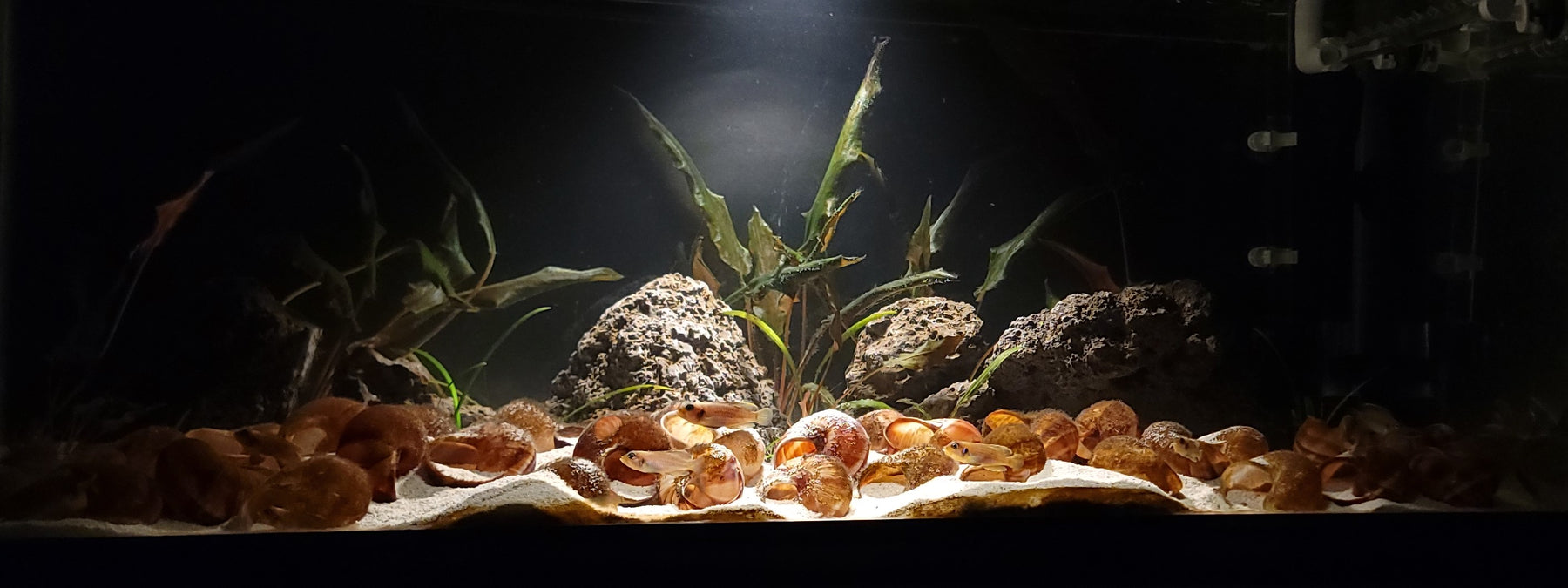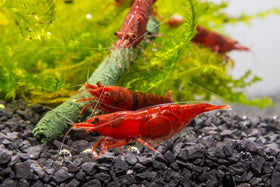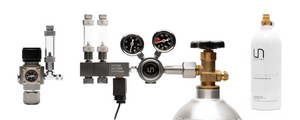
Top Aquatic Plants for a Planted Cichlid Tank
Can cichlids be kept in a planted aquarium? In most cases, usually not. Their preferred water parameters and typical behaviors prevent most aquatic plants from doing well in their aquarium. However, it’s not an impossible task to keep cichlids with live plants as long as the right plants are chosen.
In this article, we will go over plants that can work in cichlid tanks, as well as some tips and tricks you can follow to help you succeed in keeping a planted cichlid tank.

Planted Cichlid Tank Photos by @Vics_Aquatics
Why Is It Hard to Keep Plants with Cichlids?
Unfortunately, many plants will not do well in a cichlid aquarium. For example, African Cichlids do best in hard alkaline water, while aquatic plants tend to prefer soft, acidic water.
Cichlids from Lake Malawi usually do best in water with a pH of 7.4 - 7.9, so plants would have a better chance of success with them compared to Tanganyikan African Cichlids, which are generally kept in waters with a pH ranging from 8.3 - 9.3. Other cichlids, such as the ones in South America do live in soft acidic water, however, the temperature they prefer can be closer to 80°F. Such high temperatures create yet another hurdle for plants with cichlids in general.
Another reason aquatic plants don’t usually survive with cichlids is because of their destructive tendencies. Many species of cichlids love to dig pits in the substrate. They do this when they’re about to breed to create a space to lay eggs, and they can also burrow to create their own territories. Like other fish, they might also dig through the substrate when looking for any fallen food.
This behavior will cause plants to constantly get uprooted. As a result, many plants that are heavy root feeders will never successfully become established in the aquarium. Under these circumstances, those plants will eventually die from nutrient deficiency.
If the plants are not getting dug out, then they are probably being eaten. Some cichlids love to eat algae, so aquatic plants may also be on the menu for them.

Recommended Plants
Although a majority of plants cannot survive with these fish, there are a few species that have been successfully kept alongside cichlids.
1. Anubias

Anubias is one of the most popular easy-care plants in the aquarium hobby. It is an exceptionally hardy plant with thick leaves that would be too difficult for most fish to rip apart. A few of them might get nipped on, but generally not to the point where the plant will lose all of its leaves and die.
It also helps that Anubias is an epiphyte plant, meaning that it should not be buried in the substrate. Instead, it should be placed in between cracks or glued/tied to the hardscape. Since they’re not planted directly in the aquarium substrate, you wouldn’t have to worry about floating plants if the cichlids start digging holes.
*Note: Plants such as Anubias and Bucephalandra are commonly referred to as epiphytes in the aquascaping hobby. However, they are arguably closer to “rheophytes” as opposed to true epiphytes. Learn more about this in this article: Epiphyte or Rheophyte… Which Is It?
Anubias has also been known to withstand harder water conditions and can tolerate a pH level of up to 8.0. This plant comes in many variants with a range of leaf sizes, popular ones being: Anubias Nana Petite, Anubias Nana, and Anubias Barteri.
2. Java Fern

Another hardy aquatic plant that can be considered an option for a planted cichlid tank is Java Fern. While its leaves are not as thick as Anubias, they’re still tougher than most other aquarium plants. However, the new plantings that sprout when Java Fern propagates might become a snack for these fish, as their leaves would be thinner in comparison.
Java Fern is also considered an epiphytic plant, so there is no chance of it being uprooted since it wouldn’t be planted into the substrate. Similar to Anubias, it can do well in hard water and has a pH between 6.0-8.0. Luckily, there exist many varieties of Java Fern that we can use in our aquariums, including Java Fern Windelov, Java Fern Trident, and Java Fern Philippine Mini.
3. Bolbitis

Bolbitis is a genus of attractive epiphyte plants that are known for their hardiness and versatility. Their lush, textured green leaves are particularly eye-catching and can grow to be quite large, making them a suitable choice as a background plant in an aquarium. This plant can thrive in water with high pH and GH levels, which are typically preferred by cichlids.
While epiphyte plants are generally slower growing, with enough time and care, Bolbitis can develop into an impressive bush that has the potential to dominate even medium-sized aquariums. Some popular examples of Bolbitis are Bolbitis Heudelotii (African Water Fern), Bolbitis Difformis, and Mini Bolbitis.
4. Cryptocoryne

Cryptocoryne is a plant species that can be well-suited for cichlid tanks. Larger types, like Cryptocoryne Usteriana, are arguably cichlid-proof plants that can tolerate hard and alkaline water conditions. These water parameters are also favored by the East African cichlids found in Lake Malawi and Lake Tanganyika.
Cryptocoryne is a root feeder and requires a nutrient-rich substrate to thrive, similar to Echinodorus. It is recommended to root the plant deeply and provide it with fertilizer to help it establish a strong root system. The plant prefers warmer temperatures and lower levels of light, so it's important to keep this in mind. While there is a risk of the slow-growing flora being eaten by larger cichlids, this can be mitigated by keeping the fish well-fed and introducing them to the plants when they are young.
Tips and Tricks for Keeping a Planted Cichlid Tank
Select the Proper Substrate
Normally when constructing a planted tank, most aquascapes will use an active substrate like Controsoil, or some other aquarium soil. This is because this type of substrate provides nutrients for the plants to thrive in the aquarium. However, the soil will also change the water parameters, adjusting the water’s pH to neutral or even slightly acidic.
This is the opposite of what African Cichlids prefer, so it would be better to avoid using a planted tank substrate in this case. Instead, we can use an inert substrate that wouldn’t change water parameters like sand or gravel. If you have soft acidic water, you can add some crushed coral or oyster shells into the substrate to increase hardness and pH levels. The use of root tabs and fertilizers can help fix the issue of the lack of nutrients from these inert substrates.
Mindfully Choose Hardscape
Similar to the substrate, picking the right hardscape can aid us in our quest of keeping a planted cichlid tank. Some aquascaping rocks contain calcium carbonate in them. When calcium carbonate is submerged in water, it causes the water to become harder and increases the pH to a certain degree. This is great for African Cichlids since they prefer hard alkaline parameters.
Examples of aquascaping rocks that contain calcium carbonate are Seiryu Stone, Elephant Skin Stone, and Mountain Stone.
Strategic Placement of Hardscape
Planning the layout of the aquarium can really help with the success of maintaining the tank. Since cichlids are known for being territorial, the hardscape you have in the tank can serve as visual boundaries that the fish will use when creating their territories. You can structure it in a way that creates many spots for them to hide in.
The placement of the hardscape can also help keep plants from getting uprooted. If you place rocks around the plants that need to go into the substrate, the fish are unlikely to dig them out. You can also leave cracks between the stones just large enough to stick some epiphyte plants in.

Although cichlids and plants aren’t known to mix well together in the aquarium hobby, it may be possible to keep them together with the right species of fish and plants. While there are a variety of plants that have been suggested to be "cichlid-proof" and thus safe to include in a cichlid aquarium, it is important to note that no plant can be entirely guaranteed to withstand the sometimes aggressive nature of these fish.
However, it is our hope that by suggesting a range of potential options, at least a few of them will thrive in your aquarium and provide both aesthetic and environmental benefits for your fish. Following the tips and tricks mentioned should help make it easier to fulfill your goal of a planted cichlid tank!
Tell us - Was this article helpful? Please leave a comment below!
If you have any questions regarding this article, please DM us on Instagram, Facebook, or email support@buceplant.com so we can assist you - @buceplant





Comments
Leave a comment